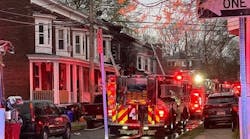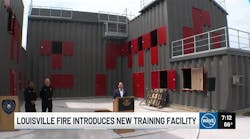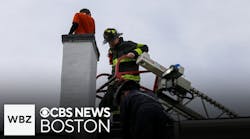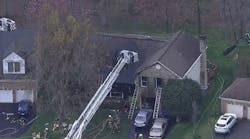This past summer my wife, Vicki, and I took our two youngest granddaughters on a trip from California to New York City and Washington, DC. This was, in part, to fulfill one of Vicki's bucket-list dreams of watching the 4th of July fireworks from the Capitol Mall (very impressive). The trip was a success and we shared lots of history, culture, and a couple of Broadway shows with our granddaughters. We also got reacquainted with humidity.
Along with visits to the Statue of Liberty, Ellis Island and Central Park (to show them Balto's statue) was a trip down to Ground Zero, the site of the terrorist attacks of September 11, 2001. The older of the granddaughters remembered that "something" had happened that day because her cartoons had been pushed off TV for a couple of days. Other than that, neither girl had any real knowledge or memories of this event that was such a part of mine and Vicki's careers and history.
We discovered that there are now three museums surrounding Ground Zero. The first and oldest is the Families Remembrance Center next door to FDNY Station 10. The second is a 9-11 Memorial Center dedicated to the establishment and building of a 9-11 Memorial at the site of the former World Trade Center and the third is a NYC 9-11 museum. We only had time for two of the three centers and each had a museum bookstore to help raise funds to keep the respective museum in operation. Among the books and DVDs I purchased was Covering Catastrophe: Broadcast Journalists Report September 11th.
Edited by Allison Gilbert, Phil Hirshkorn, Melinda Murphy, Robyn Walensky and Mitchell Stephens, Covering Catastrophe is one fast-paced series of snapshots from multiple perspectives on the events of September 11, 2001. The book consists of multiple first-person accounts assembled in chronological order about experiences of the media that day, from attempts to get to the various sites, to sorting through the rumors to get the true facts as these unprecedented, and almost unimaginable, events unfolded.
More than 250 reporters, producers, cameramen, news media helicopter pilots, news anchors, news executives and independent stringers shared their stories of that tragic day. Their tales are assembled in bite size, some as short as a single paragraph and none longer than a page and a half.
The stories include everything from being on air in the media center at the Pentagon and being jarred as American Airlines Flight 77 crashed into it, to being on the freeway outside on the way to work and witnessing Flight 77 fly within a few dozen feet on its deadly course, to covering President Bush's notification of events in a Florida schoolroom and being whisked out onto Air Force One to a series of unknown destinations.
The five reporters and producers who collected and assembled all of these stories did an excellent job. The actual events are reported succinctly and graphically, including multiple accounts of being at what is now known as Ground Zero, surviving the collapse of multiple buildings, and finding a way to get the word and story out. Because these are reporters, the events and emotions, along with the problems and difficulties of figuring out just what exactly was happening, are communicated with an economy of words. Neither over-sensationalized nor downplayed, but rather shared with a near-perfect perspective.
We also see the frustrations of rural Pennsylvania emergency responders who were dispatched to a report of plane crash only to find nothing…nothing except a 20-by-40-foot hole in the ground with a few smoldering trees. No wreckage, no survivors, no bodies or even body parts. Nothing. The reporters who responded to the scene at first were disbelieving that this could have been an airliner (United Airlines Flight 93), but soon came to the realization of what had occurred.
Not only are events from the field covered, including hiring a private sailboat to transport a pool of reporters and cameramen from New Jersey across the Hudson River into Manhattan, but also the challenges at the network broadcast centers. Accounts from nightly news anchors Tom Brokaw, Brian Williams and Dan Rather are included along with perspectives from their producers and major news executives. They discuss sorting facts from the multiple rumors, getting confirmation, lining up various subject matter experts and dealing with a frequently desperate public calling in requesting searches for missing loved ones.
Nearly 3,000 people lost their lives that day. Covering Catastrophe is a very well written and fast-paced series of first-person accounts of both the events and the efforts to report them that can be consumed in an afternoon or read at a more leisurely pace. It is an excellent historical look at those events of nine years ago and also should be near mandatory reading for every emergency service public information officer.
COVERING CATASTROPHE
Edited by Allison Gilbert, et al
Bonus Books, 2002
ISBN: 1-56625-180-X
$24.95
Known variously as the Code Warrior and the 911 Cowboy, NORM ROOKERhas been involved in EMS & Rescue since 1973. His career has covered numerous venues, from the City of St. Louis to the streets of San Francisco, and have ranged from standard EMS and supervision to Special Operations including structural collapse rescue, SWAT/Tactical EMS, surf rescue swimmer and rope-rescue geek, among others. He recently retired as Chief of Ouray County EMS in southwestern Colorado and is a wildland fire Medical Unit Leader and a consultant as well a speaker on the EMS & Rescue lecture circuit. He is a past member of the NASAR Board of Directors and a founding member of the International Assoc. of EMS Chiefs where he currently serves as the Rural EMS Chiefs section head.





